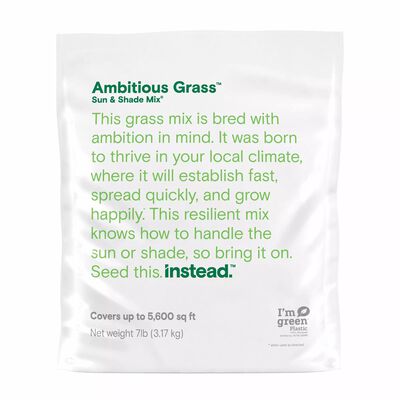
Grow Green Grass, Naturally
Get the lawn you love, and one the Earth loves, too.
When it comes to an amazing lawn, modern homeowners can often feel conflicted. You shop organically and want your domestic space—indoors and out—to be driven by nature. So, how can you get a yard full of thick, green grass without the help of chemicals? The answer is twofold: A dedicated lawncare regimen and the right all-natural products to keep it grooving.
Here's how to grow green grass, naturally, in just five steps. Plus, a few pro tips for the overachievers (we know how it goes).
Grow Greener in Five Steps
Life is too short for hard and fast rules, but guidelines can make the grass greener on your side of the fence. Once you get these basics down, keeping it that way is pretty easy.
1. Fertilize Regularly
Think of fertilizing as that healthy shake you drink to bolster a gym session. Your grass is out there working hard each season and if there aren't any new nutrients to suck down, it can start to fade. Fertilizer gives it a fresh supply of nutrients so it can keep on growing. You can keep this step chemical-free by applying a product like instead™ Happy Lawn™, which uses all-natural ingredients to give your lawn a boost.
2. Mow Like a Pro
Whether you think your lawn looks better with a buzzcut or slightly longer locks, a happy medium is actually best. Grass that is mowed to 2.5 or 3 inches in height develops deeper roots, which help push out weeds and minimize the amount of products you need to keep it looking good. Plan to head out in early evening to give it a mow: Daytime temps are already stressful enough on grass, so waiting until it's a little cooler before you zig-zag across your lawn is easier on everyone.
3. Water Responsibly
Your lawn doesn't need to be watered every day: You could rely on rainfall alone to give your grass what it needs. However, some seasons are drier than others, so if your lawn is looking dull, it's time to step in with water. Use a smart sprinkler system or set the timer for early in the morning—before 10am—so the water can soak into the soil before the sun hits. Different sprinklers put out different amounts, so check the label directions, but the goal is to give your lawn 1 to 1.5 inches of water a week.
4. Assist with Seed
Grass seed isn't just for planting new lawns; it can help thicken up thin areas and fill in bare spots around a yard that's seen a lot of action, too. No matter what mission you're on, make sure you choose a premium seed that matches your grass type. Once you're ready, grab a rake and loosen the top layer of soil. Then, whether with a spreader or a gloved hand, put down the seed. Water the area and voilà! The hardest part just might be keeping kids and pets off of it until you see seedlings at least 3 inches tall.
5. Tackle Weeds
When a weed pops up, pull it out before it has the chance to spread its seed all over your gorgeous lawn. For a larger problem, try spot-treating the weeds with a natural product (you can even make your own weed killer) to keep them at bay. Weeds are probably the best reason to stick to a lawn care regimen: If you consistently care for the grass growing in your yard, they won't have a chance to creep in.
Top Tips for Fine-Tuning
As with anything, after you've learned the general facts, it's all about fine-tuning. Think of these tips as supporting the grass guidelines above.
Save Your Grass
When you mow, don't bag those grass clippings and throw them out. Either leave them right on the grass or add them to your compost pile—it's like added fertilizer either way. Also, you can sweep the clippings that landed on your sidewalk or driveway back onto the lawn for even more bonus material.
Stay Sharp
Sharp mower blades make cleaner cuts. Dull blades rip and tear grass, making it prone to disease. (Plus, it looks raggedy in a way that gives natural lawn care a bad name.) If you're not comfortable removing the blade to sharpen it yourself, just take it to a repair shop to have it done.
Alter Your Path
When you mow in the same direction every time, you can end up creating ruts in the ground that cause grass to grow unevenly. Alter your path each time you mow and you'll avoid ruts, plus your grass will stand up nice and tall since you'll be going at it from different directions.
Natural lawn care is easy when you know your options. Now you can feel good about the choices you're making for yourself, your family, and the world—and have some fun in your own little corner of it.


